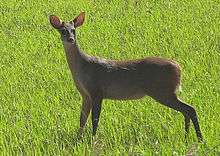Red brocket
The red brocket (Mazama americana) is a species of brocket deer from forests in South America, ranging from northern Argentina to Colombia and the Guianas.[1][2] It also occurs on the island of Trinidad in the Republic of Trinidad and Tobago (it also occurred on the island of Tobago until very recent historical times, but appears to have been extirpated there due to ineffectively regulated hunting of wild game practiced on the island).
| Red brocket | |
|---|---|
_male_(28091090800).jpg) | |
| Scientific classification | |
| Kingdom: | Animalia |
| Phylum: | Chordata |
| Class: | Mammalia |
| Order: | Artiodactyla |
| Family: | Cervidae |
| Subfamily: | Capreolinae |
| Genus: | Mazama |
| Species: | M. americana |
| Binomial name | |
| Mazama americana (Erxleben, 1777) | |
 | |
It formerly included the Central American red brocket (M. temama) and sometimes the Yucatan brown brocket (M. pandora) as subspecies.[3] Considerable taxonomic confusion still exists for the populations remaining in the red brocket. Pending a solution to this, it has been evaluated as data deficient by the IUCN,[1] though as presently defined, it is the most widespread species of brocket. It is sympatric with the smaller Amazonian brown brocket over much of its range (the latter tends to have significantly lower population densities). The karyotype of the red brocket was initially described as having 2n = 68, FN = 74, and more recently as having 2n varying from 48 to 54 and FN varying from 54 to 56.[1] This variability may indicate the presence of unrecognized species in the population.[1]
Its body is reddish-brown in color, with a lighter grayish-brown head and neck, and partially blackish legs.[4] The inner thighs and the underside of the tail are white. Fawns are spotted white and lack blackish to the legs.[4] Only the adult male has antlers, and these are small and spike-like. This species is the largest of the brockets. The shoulder height is 67–80 cm (26–31 in) and the head and body length 105–144 cm (41–57 in).[4] These deer typically weigh 24–48 kg (53–106 lb),[4] but exceptional males may get as large as 65 kg (143 lb).[5]
The red brocket browses on vegetation, preferring fruit when it is available. It is generally solitary and stays in dense jungles. When alarmed, the animal snorts or stomps its hooves.
Gallery
 Mazama americana
Mazama americana.jpg) Red brocket heart, specimen clarified for visualization of anatomical structures
Red brocket heart, specimen clarified for visualization of anatomical structures
References
- Duarte, J.M.B.; Vogliotti, A. (2016). "Mazama americana". IUCN Red List of Threatened Species. 2016: e.T29619A22154827. Retrieved 19 December 2019.
- Grubb, P. (2005). "Order Artiodactyla". In Wilson, D.E.; Reeder, D.M (eds.). Mammal Species of the World: A Taxonomic and Geographic Reference (3rd ed.). Johns Hopkins University Press. pp. 637–722. ISBN 978-0-8018-8221-0. OCLC 62265494.
- Medellín, Rodrigo A.; Alfred L. Gardner; J. Marcelo Aranda (April 1998). "The taxonomic status of the Yucatán brown brocket, Mazama pandora (Mammalia: Cervidae)" (PDF). Proceedings of the Biological Society of Washington. 111 (1): 1–14. Archived from the original (PDF) on 22 July 2011. Retrieved 10 October 2010.
- Trolle, M., and L. H. Emmons (2004). A record of a dwarf brocket from lowland Madre de Dios, Peru. Deer Specialist Group Newsletter 19: 2–5
- Nowak, R. M. (eds) (1999). Walker's Mammals of the World. 6th edition. Johns Hopkins University Press.
- Emmons, L.H. (1997). Neotropical Rainforest Mammals, 2nd ed. University of Chicago Press ISBN 0-226-20721-8
External links
| Wikimedia Commons has media related to Mazama_americana. |
- Images and information – www.arthurgrosset.com
